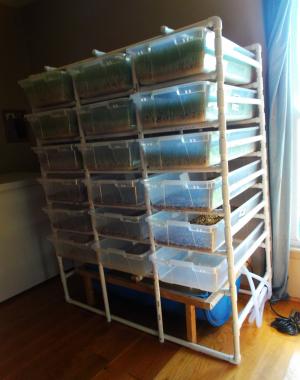Hydroponic Fodder System Helped Them Survive Drought
 ✖  |
When his Springfield, Missouri area was hit by a bad drought last summer, Caleb Howerton knew he needed creative options to get his livestock through the fall and winter with limited hay reserves. He decided to build a hydroponic fodder system to grow grass and sprouted grains.
Caleb built a frame for the fodder system out of 3/4-in. pvc pipe and 3/4-in. pvc T and elbow connecters. Each of the 6 shelves holds 3 plastic trays for the seed to grow in for a total of 18 trays, each with holes drilled in the bottom to facilitate drainage. Half of a 55-gal. barrel under the shelf serves as a water reservoir, which cycles the water through an irrigation array made of 1/2-in. pvc pipe.
Water is pumped to the top of the system from a pond pump and provides overhead watering to the top 3 trays, which then drain through each layer until the water cycles back to the reservoir. A complete water change is done once a week to prevent the water in the reservoir from becoming stagnant.
About .4 lbs. of soaked seed (a mix of 50 percent wheat seed, 25 percent black oil sunflower seed, and 25 percent fall forage mix) is added to one layer of trays each day, and every day one layer is fed to the livestock for a continuous cycle. At the end of its 7-day growth period (6 days in the system, and 1-day soaking) about 30 lbs. of fodder per tray is produced. The fodder is fed as a pasture supplement to Caleb’s rabbits, Idaho Pasture Pigs, dairy goats, sheep, chickens, and horse.
Contact: FARM SHOW Followup, Caleb Howerton, 1008 E. Farm Rd. 54, Springfield, Mo. 65803.

Click here to download page story appeared in.
Click here to read entire issue
Hydroponic Fodder System Helped Them Survive Drought CROPS New Crops When his Springfield Missouri area was hit by a bad drought last summer Caleb Howerton knew he needed creative options to get his livestock through the fall and winter with limited hay reserves He decided to build a hydroponic fodder system to grow grass and sprouted grains
Caleb built a frame for the fodder system out of 3/4-in pvc pipe and 3/4-in pvc T and elbow connecters Each of the 6 shelves holds 3 plastic trays for the seed to grow in for a total of 18 trays each with holes drilled in the bottom to facilitate drainage Half of a 55-gal barrel under the shelf serves as a water reservoir which cycles the water through an irrigation array made of 1/2-in pvc pipe
Water is pumped to the top of the system from a pond pump and provides overhead watering to the top 3 trays which then drain through each layer until the water cycles back to the reservoir A complete water change is done once a week to prevent the water in the reservoir from becoming stagnant
About 4 lbs of soaked seed a mix of 50 percent wheat seed 25 percent black oil sunflower seed and 25 percent fall forage mix is added to one layer of trays each day and every day one layer is fed to the livestock for a continuous cycle At the end of its 7-day growth period 6 days in the system and 1-day soaking about 30 lbs of fodder per tray is produced The fodder is fed as a pasture supplement to Caleb’s rabbits Idaho Pasture Pigs dairy goats sheep chickens and horse
Contact: FARM SHOW Followup Caleb Howerton 1008 E Farm Rd 54 Springfield Mo 65803
To read the rest of this story, download this issue below or click
here to register with your account number.







